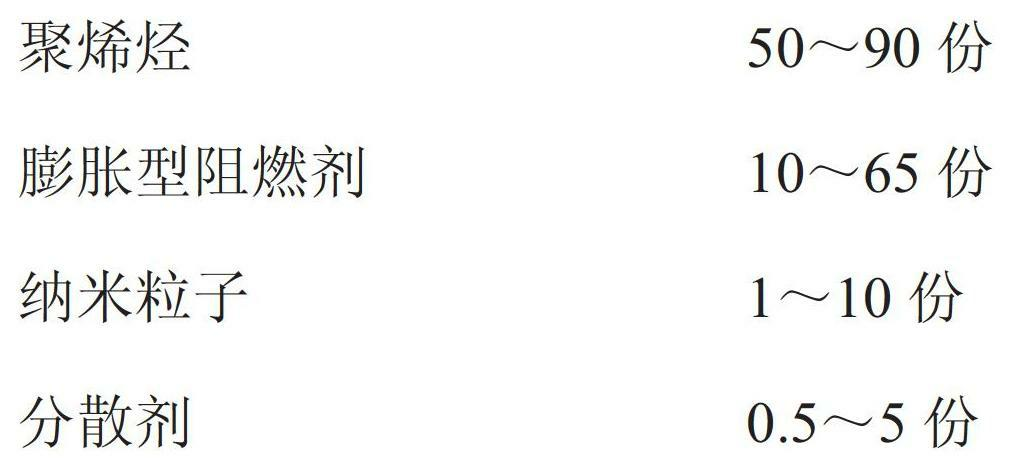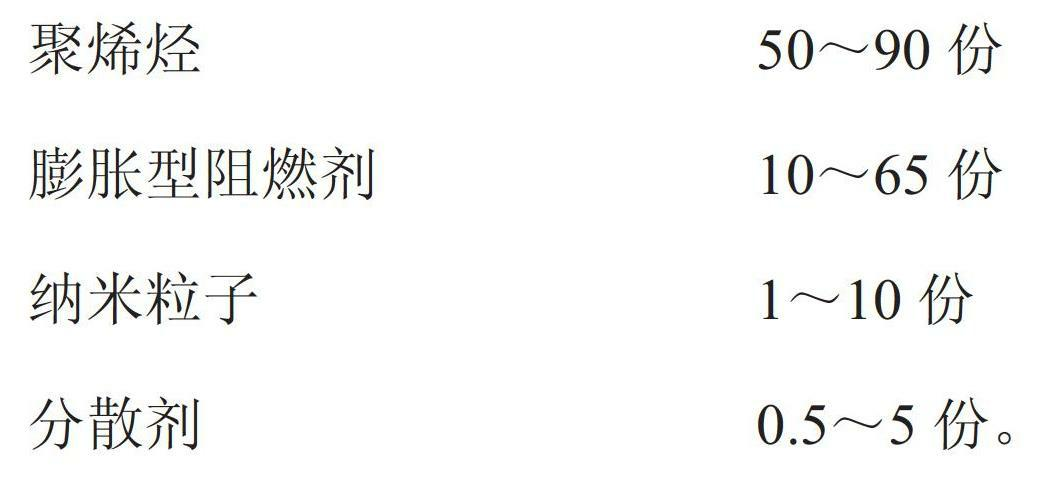Nano halogen-free flame retardant polyolefin material and preparation method thereof
A polyolefin and nano-technology, applied in the field of nano-halogen-free flame-retardant polyolefin materials and its preparation, can solve the problems of decreased mechanical properties, large addition of flame retardants, toxicity, etc., and achieve good elasticity, high strength, and good resistance. The effect of flammability
- Summary
- Abstract
- Description
- Claims
- Application Information
AI Technical Summary
Problems solved by technology
Method used
Image
Examples
Embodiment 1
[0020] After vacuum drying 70 parts of polyolefin, 20 parts of ammonium polyphosphate, 9 parts of nylon 6, and 1 part of urea, add 1 part of polyolefin wax and mix in a high-speed mixer at 80 ° C for 10 minutes. , Extruded and granulated in a twin-screw extruder with temperature control in six zones. The processing temperatures in zones one to six are: 190°C, 190°C, 195°C, 195°C, 200°C, and 190°C. The pellets are pressed into tablets on a flat vulcanizing machine at 165-170°C, and cut into standard strips on a universal testing machine as required for testing combustion performance and mechanical properties.
Embodiment 2
[0022] After vacuum-drying 70 parts of polyolefin, 20 parts of ammonium polyphosphate, 9 parts of nylon 6, 1 part of urea, and 2 parts of cetyltrimethylammonium bromide-modified sodium montmorillonite, add 1 part of poly The olefin wax was mixed in a high-speed mixer at 80°C for 10 minutes, and the above mixture was extruded and granulated in a twin-screw extruder with an aspect ratio of 32 and temperature control in six zones. The processing temperatures in the first to sixth zones were as follows: : 190°C, 190°C, 195°C, 195°C, 200°C, 190°C. The pellets are pressed into tablets on a flat vulcanizing machine at 165-170°C, and cut into standard strips on a universal testing machine as required for testing combustion performance and mechanical properties.
Embodiment 3
[0024] After vacuum drying 70 parts of polyolefin, 20 parts of ammonium polyphosphate, 9 parts of nylon 6, 1 part of urea, and 2 parts of nano-A12O3, add 1 part of polyolefin wax and mix in a high-speed mixer at 80 ° C for 10 minutes. The mixture is extruded and granulated in a twin-screw extruder with an aspect ratio of 32 and temperature control in six zones. The processing temperatures in zones one to six are: 190°C, 190°C, 195°C, 195°C, 200°C, 190°C. The pellets are pressed into tablets on a flat vulcanizing machine at 165-170°C, and cut into standard strips on a universal testing machine as required for testing combustion performance and mechanical properties.
[0025] The specific data of each instance are shown in the table below:
[0026] The test data of each embodiment of table 1
[0027]
PUM
| Property | Measurement | Unit |
|---|---|---|
| oxygen index | aaaaa | aaaaa |
| oxygen index | aaaaa | aaaaa |
Abstract
Description
Claims
Application Information
 Login to View More
Login to View More - R&D
- Intellectual Property
- Life Sciences
- Materials
- Tech Scout
- Unparalleled Data Quality
- Higher Quality Content
- 60% Fewer Hallucinations
Browse by: Latest US Patents, China's latest patents, Technical Efficacy Thesaurus, Application Domain, Technology Topic, Popular Technical Reports.
© 2025 PatSnap. All rights reserved.Legal|Privacy policy|Modern Slavery Act Transparency Statement|Sitemap|About US| Contact US: help@patsnap.com


